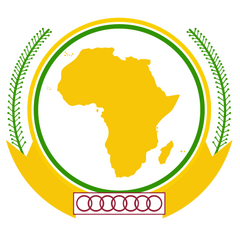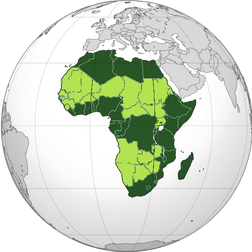| African Union تقاطع الأفريقية Makutano ya Africa | |

| |
 The location of the African Union | |
| Capital | Nairobi 39,348,000 inh. |
| Largest City | Lagos 69,003,598 inh. |
| Official Language | None. English most widely spoken language |
| Goverment Type - Prime minister: |
Federation -Jamal Kikwete |
| Establishment | 1950 |
| Area | 29, 757, 900 km2 |
| Population | 3,970,348,000 inh |
| GDP | ₡14.2 trillion |
| HDI | 0.700 |
| Currency | Credit ₡ |
| Demonym | African |
| Administrative Divisions | 54 states 19 temporarily suspended states |
| Religion | 55% Atheism |
| Armed Forces | None. See UN Army |
The African Union lags behind much of the rest of the world but this is relative – much of the continent would be unrecognisable in terms of development in comparison to the Africa of the early 21st century, thanks to massive investment from China and India, and to a lesser extent Europe, but also due to the increasing stability on the continent, at least in certain areas.
The African Union is built upon these pockets of stability, referred to as the ‘Three Pillars’, centred on Nigeria, Azania and the highly integrated EAF of Kenya, Tanzania, Ethiopia and Uganda. These developed countries have achieved robust democracies, middle income economies and political unity, but they are separated by vast areas of depopulated desert and failed states occupied by the UN peacekeeping forces, linked by spans of superhighways that channel raw resources (in particular mineral ores) out of Africa to the vast Eurasian economies.
The African Union also has a vast industrial base, fuelled by raw materials and cheap labour and supported by three orbital elevators, one outside Libreville and another one in Lagos on the West coast, the other on the East coast, not far from Nairobi, Mombasa and Zanzibar.
Although the population of the continent doubled in just fifty years Africa’s supposedly imminent population boom never really got under way (strict measures were introduced to reduce birth rates) and much of the populace emigrated, refugees of a continent stricken by climate change. It is fortunate, for it seems highly unlikely that the continent could have supported the five billion plus inhabitants it was predicted to have – it is currently home to about two and a half billion and even as it stands hundreds of millions languish in poverty, though since the mid-2090s the situation has improved considerably. The towns and cities of the African Union have been more-or-less built from scratch over the course of the past few decades, purpose-built, utilitarian and bland as shanties and townships were paved over, but diverse African culture nevertheless persists in the social traditions, music and art of the Union. It also remains one of the last refuges of widespread practising of traditional religion outside the Middle East – whilst many cultures still celebrate their various religious festivals (Christmas, Diwali, Eid etc.) Africa is one of the few remaining regions in which actual belief holds a majority over atheism or agnosticism (54% as of 2150). The north of the continent is largely Islamic, whilst the southern half under the African Union is predominantly Christian following trends set ever since the European colonisation of the continent around three centuries earlier.